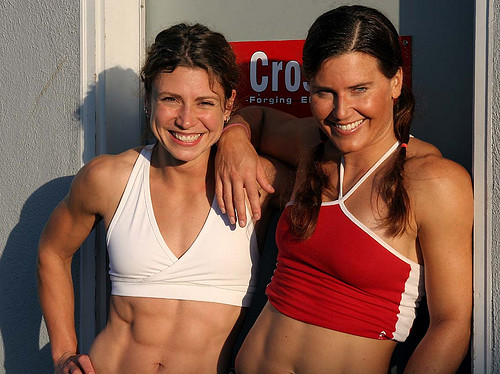I get a lot of questions about why we do the type of strength training programs that we do. ?As you may or may not know we have experimented with many different programs here at CFB. ?Most strength programs will work for most people if you stick with them and stay consistent. ?We at CFB study all the literature, and try to find what the best program would be to provide the greatest adaptation to the largest number of people (aka what will make the gym stronger faster?). ?In doing so, we are constantly tweaking and experimenting and implementing things that we’ve seen work, taking out things that we have seen didn’t work and using techniques that we come across in our studies that we think may work. ?We also rely heavily on our back grounds and experience in exercise science, sports medicine, and Division 1 athletics to make informed decisions. ?All that being said let’s visit some strength training concepts.
In order to understand strength training, one must first look into a couple of different concepts. ?In an effort to not bore you to tears, I will try to keep this brief.
The first concept is training age or maturity. ?Mark Rippetoe, a strength coach who has literally written books on strength training and been in the business for more years then I’ve been alive, has some great strength standards where he divides you into your training maturity. ?The standards can be found here! In it, he classifies people as untrained, novice, intermediate, advanced, and elite. ?These are some good classifications, and the charts are pretty good reference points, if you are wondering where you fall in the strength training world. ?For all of my lifts, I actually fall somewhere between Intermediate and Advanced. ?I have to say, you are pushing some serious weight to be classified as elite!
The second concept that should be noted is the idea of the weight training spectrum or rep ranges. ?This can be more specifically classified as time under tension, but that is way too deep for this conversation. ?The idea is that the higher a % of your 1 rep max a weight is, the less reps you will be able to do, but the stronger you will get by doing it. ?To put it more clearly this is what you’ll see in most exercise physiology text books (these are not written in stone, in fact a common theme with the human body is nothing is written in stone):
1-6 reps = strength ; 6-12 reps= hypertrophy (muscle growth); 12-20+ = endurance
If you get real technical these rep ranges vary from person to person and from muscle to muscle. ?It also depends on how fast you do each rep. ?The real factor involved has to do with how much time the muscle is under tension. ?This will generate the type of stimulus you are trying to elicit. ?Ok, ok enough exercise physiology.
Our goal is to get stronger, be more functionally fit (generally physically prepared) and let’s be honest, to look better naked, so what the heck should we do?
?
There are tons of ‘cook book’ methods out there to choose from depending on what you want. ?The problem with cook books is that no matter how well the dish looks in the picture, you do not have a professional chef in your kitchen preparing it. ?You also do not have the chef’s experience or thought patterns. ?Following the same logic, it is hard to find a cook book program that will work for you. ?You don’t have the same knowledge base, experience, body type, etc etc to make the program exactly work for you.
We have tried many different methods in our gym and most of them worked for a time. ?We did the Conjugate Method proposed by Louise Simmons. ?This method is great, and will get people stronger who follow it. ?The problem we saw in our gym is that you are supposed to change different types of lifts. ?For example, bench press, floor press, 2 board press, rack press, etc. etc. etc. ?This is great if you are following it one on one with someone, but in a large group setting and with 130 members with some people coming only 3 times a week and some people coming 4 or 5, it’s very difficult to keep everyone on track and moving in the same direction. ?The other problem with the Conjugate method is that it is for advanced lifters aka people who will stop progressing on a novice-intermediate program. ?This isn’t to say that novice and intermediates will not get stronger on the Conjugate method, but there are better options that will produce better results.
?
The other options are used primarily for untrained- advanced lifters and they are called linear progressions. ?There are many forms of linear progressions some of the most popular include Rippetoe’s Starting Strength, and Wendler 5/3/1. ?There are also some popular ones in the CrossFit world called Max Effort Black Box, and CrossFit Strength bias. At CFB we have incorporated versions of all of these at one time or another. ?Most people have progressed with these programs as well, but we are always looking for something better.
The program we are doing now is hybrid of a couple different linear programs but it takes advantage of several key elements. ?One of the top reasons we like the current cycle is it’s easy for people to understand. ?One set to 5, one set to 5, then one set to failure. ?Not a hard concept. ?The use of 5 reps is fairly important. ?If you remember our discussion earlier, 5 reps falls into the ‘strength’ side of the rep range. ?The beauty of this program is that the 5 reps, with volume built into the set of failure also lean towards hypertrophy (that’s a good thing for the looking better naked part). ?The failure set also has several other key benefits. ?It helps the athlete neurologically. ?Being able to push one’s self to failure creates neural and hormonal responses to stress. ?This all leads to better strength and body composition. ?The set to failure also helps build strength endurance. ?Strength endurance will help you push a heavier weight longer. ?This will build strength and cause muscle growth. ?Besides all those benefits, for me personally, the best part of this program is trying to hit a personal record each day. ?Every time we do a lift our goal is to either hit more reps or more weight. ?Even if you went up by 1lb that is still a personal record! ?This is extremely motivating for me, and it helps me push harder then I would normally.
As you can see, a lot of thought goes into picking what type of program we do. ?We have been doing this type of program for 15 weeks now, and for the most part everyone is improving fairly quickly. ?In fact, the last time we tested it was not uncommon to hear, ‘I added 30lbs on to my deadlift!’ ?That is truly awesome to hear, and I am excited that people are getting results. ?We are continually tweaking to make it better, but for right now, let’s see some PR’s!
Jeff focusing on his jerk!





